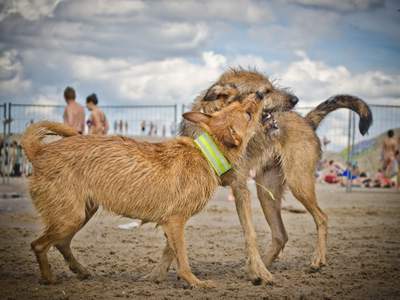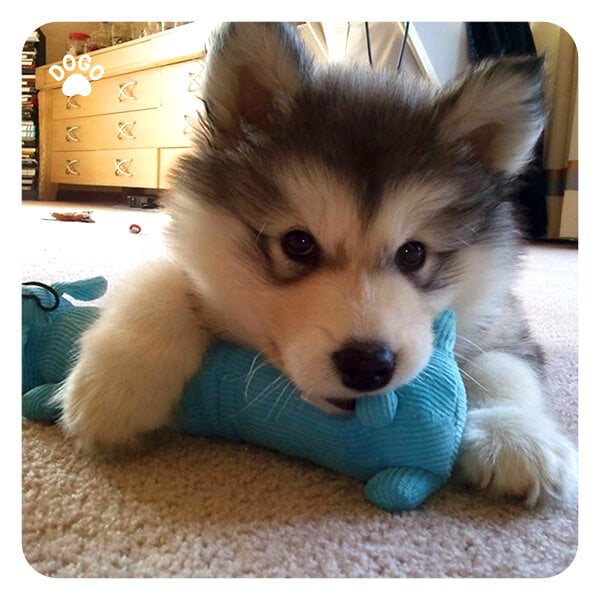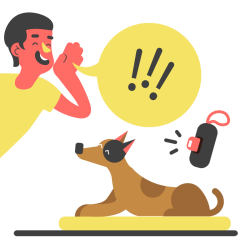Why My Puppy Bites and How to Stop It?
Post Date:
July 18, 2024
(Date Last Modified: November 13, 2025)
Puppy biting covers a range of behaviors from gentle mouthing to forceful strikes and can mean different things depending on age, context, and the puppy’s health. Clear descriptions of bite types, practical safety steps, and humane training techniques help owners respond effectively.
Types and Severity of Puppy Bites
Mouthing and nipping are typically low‑force behaviors seen in puppies younger than 6 months as they explore and play[1]. Play bites involve brief pressure without intent to harm, while hard bites produce punctures, tearing, or bleeding and carry a higher risk of infection and medical treatment[1]. Defensive bites, often triggered by fear, are directed and may be stronger than play bites; distinguishing intent helps decide whether a veterinary exam or behavior intervention is needed[1].
| Bite Type | Observable Signs | Injury Risk | Owner Response |
|---|---|---|---|
| Mouthing | Gentle pressure, licking, no skin puncture | Low | Redirect to toy; teach soft mouth |
| Nipping/Play bite | Intermittent mouth contact, excited body language | Moderate | Interrupt play; time-out or ignore briefly |
| Hard bite | Yelp or withdrawal by human, bleeding or puncture | High | Veterinary evaluation if skin broken; seek behavior help |
| Defensive bite | Growl, stiff posture, avoidance beforehand | High | Manage triggers; consult behavior professional |
Developmental Timeline and What’s Normal by Age
Puppies erupt deciduous (baby) teeth starting around 3 to 6 weeks, and adult teeth typically begin to come in at about 12 weeks with teething often finishing by roughly 6 months[2]. The primary socialization window, when puppies are most receptive to learning about people and other animals, is commonly identified as between 3 and 14 weeks[3], and experiences in that window strongly influence how puppies interpret bite feedback from littermates and humans[3]. Peak mouthing and teething-related chewing often occur between about 3 and 6 months of age; many puppies show reduced biting frequency after that period as adult teeth settle and training takes effect[4].
Common Immediate Causes and Triggers
Puppies bite for several common reasons including oral discomfort from teething, high arousal during play, exploratory behavior, attention‑seeking, and frustration when they cannot access desired items. Environmental factors such as loud rooms, crowded handling, or lack of appropriate chew outlets increase the chance of problem biting. Human responses—yelling, pushing the puppy away, or inadvertently rewarding mouthing with attention—can reinforce unwanted biting behaviors.
- Teething and oral pain
- Excitement and play arousal
- Exploration and sensory investigation
- Attention‑seeking and learned outcomes
- Overstimulation or lack of outlets
Identifying the immediate trigger lets the owner apply a targeted response: comfort and chew options for teething, calm redirection for excitement, and management for overstimulation.
Bite Inhibition and Social Learning
Bite inhibition is the puppy’s learned ability to control jaw strength; littermates and the dam provide the first lessons by yelping, withdrawing, or ending play when pressure is too strong. Human cues that mimic this feedback—an audible, short yelp or an immediate, calm withdrawal of attention—help puppies understand limits when littermates are not present. Most puppies begin showing measurable improvement in bite inhibition within weeks of consistent social feedback and often continue refining control through the juvenile period; reliable, adult-level inhibition is commonly established by the time basic social maturity is reached, though exact timing varies by individual and breed[3].
Immediate Management and Safety Measures
Supervision and environmental management reduce the risk of injury while training continues. Use leashes, baby gates, or confined play areas to prevent unsupervised interactions with children or guests and remove high‑value items that provoke resource guarding. After a bite that breaks skin, seek veterinary care to assess wound depth and infection risk; surface abrasions may be cleaned at home but punctures and persistent bleeding require professional evaluation[1].
If a bite occurs during play, immediate, calm withdrawal of attention is effective: stopping play and placing the puppy in a brief, low‑stimulation timeout helps the puppy associate biting with the loss of reinforcement. Short time‑outs of about 30 seconds are often recommended to interrupt and reset the interaction without over‑punishing the puppy[5].
Positive Training Techniques That Work
Positive, reward‑based approaches consistently outperform aversive methods for reducing puppy biting while preserving the human‑dog relationship. Redirecting a puppy’s mouth to an appropriate chew toy and immediately trading for a higher‑value toy or treat teaches the puppy that offering a toy earns rewards. Reinforce calm, non‑mouthy postures with short, frequent rewards and end play sessions calmly when the puppy becomes overexcited so arousal does not escalate into hard biting. Avoid physical punishment, which tends to increase fear and defensive responses rather than teach inhibition.
Play Management and Teaching Appropriate Interaction
Structure interactive play so the puppy learns clear rules: use toy‑based games instead of hands‑as‑toys, limit roughhousing that encourages full‑force mouthing, and set predictable starts and stops so the puppy understands boundaries. Teaching cues such as “gentle,” “leave it,” and a reliable recall during moderate excitement helps owners control situations that might otherwise trigger biting. Short, focused play sessions with built‑in calm breaks—for example five to ten minutes of supervised play followed by a quiet rest—reduce overstimulation and give repeated training opportunities[5].
Socialization with well‑mannered, vaccinated adult dogs or calm juvenile dogs provides ongoing practice in bite inhibition; supervised dog‑to‑dog play allows puppies to learn limits from conspecific feedback more naturally than solitary training can.
Managing Teething and Physical Comfort
Teething is both a behavioral and physical driver of increased mouthing; providing safe, durable chews and toys—including chilled or frozen chew items—offers counterpressure that can reduce destructive mouthing. Offering a frozen chew for a short session relieves soreness without consuming excessive time; many caretakers use frozen chews for roughly 10 to 15 minutes per offering to reduce discomfort and prevent cold sensitivity[4].
If a puppy shows signs of severe oral pain, swelling, persistent drooling, or reluctance to eat, consult a veterinarian; diagnostic and treatment options vary with cause. When medication is prescribed, clinicians calculate doses carefully by weight and express liquid medication regimens in mL/kg/day to ensure accuracy and safety[2].
Fear, Anxiety, and Aggression‑Driven Biting
Bites rooted in fear or resource guarding look different from playful nips: cues include fixed gaze, stiff posture, pinned ears, growling, or attempts to move away before biting. These patterns indicate that the puppy is signaling discomfort, and responses should focus on reducing threat perception through counterconditioning and desensitization rather than punishment. Systematic desensitization paired with positive reinforcement—gradually exposing the puppy to the trigger at a low intensity and rewarding calm behavior—can reshape emotional responses over time.
When biting is frequent, escalating, or combined with clear signs of aggression, involve a certified behaviorist or veterinary behaviorist; professionals create individualized plans that may include structured behavior modification and safety protocols to protect people and the dog while progress is made[1].
Monitoring Progress and Setting Realistic Goals
Track biting incidents to evaluate whether an intervention is working: record the number of bites, context (play, food, fear), and who was present. Aim for short, measurable improvements—many trainers recommend brief practice blocks of 3 to 5 minutes each, repeated about 4 to 6 times per day for focused skill work[5]. With consistent, reward‑based training and management, owners commonly see noticeable reduction in mouthing within 2 to 4 weeks[5].
Use objective targets so progress is clear: for example, reduce the daily frequency of loud play bites by half within 2 weeks, or increase the puppy’s calm hold time to at least 30 seconds before a reward is given. If counting incidents, include only bites that make skin contact; brief air nips without contact are scored differently because they indicate very different arousal and control levels[1].
Working Safely with Children and Vulnerable Adults
Never leave a puppy unsupervised with children under 5 years old; close supervision is advised for older children until the puppy reliably inhibits mouth pressure and follows basic cues[5]. Teach children to use toys as intermediaries for play, to keep hands flat and fingers together when accepting a toy, and to stop play immediately if the puppy becomes overaroused. Structured, adult‑led play sessions of 5 to 10 minutes reduce the chance that excitement will escalate into hard biting[5].
Puppy Classes and Controlled Socialization
Puppy socialization classes provide supervised practice where puppies learn bite inhibition and appropriate greetings; many clinics and training organizations accept puppies into classes once they have had at least their initial wellness exam and early vaccinations, often around 8 to 12 weeks depending on local veterinary guidance[4]. In classes, instructors typically keep exercises short—often 5 to 15 minutes per activity—to maintain low stress and avoid overstimulation, and they emphasize safe, calm interactions over rough play[3].
Advanced Strategies for Persistent Biting
If a puppy continues to bite with increasing force despite consistent management, advanced techniques can help. Counterconditioning pairs the appearance of a trigger with predictable, high‑value rewards to change the puppy’s emotional response; volume and timing matter, so rewards are delivered within 1 to 2 seconds of the desired calm behavior to strengthen the association[3]. For resource guarding, teaching an explicit “trade” sequence where the owner offers a treat in exchange for the item and then rewards the exchange is a stepwise method many professionals use before progressing to more complex desensitization exercises[1].
When behavior is complex—rapid escalation, repeated puncture wounds, or biting directed at multiple family members—seek a professional assessment. Certified applied animal behaviorists or veterinary behaviorists can typically provide a formal behavior plan and safety protocols; the decision to refer is often made when risk cannot be adequately managed at home or when a puppy’s behavior does not improve after 2 to 4 weeks of consistent, documented training efforts[1].
Medication, Medical Causes, and When to Reassess
Medical problems can increase irritability and biting: dental infections, oral foreign bodies, or systemic illness may present as sudden changes in mouthing behavior. If a puppy shows acute onset of aggressive mouthing or pain signs—such as flinching when the mouth is touched, reluctance to eat, or excessive drooling—arrange a veterinary exam; clinicians often recommend wound checks or oral exams for any bite that punctures skin or is followed by persistent bleeding[2].
When medication is indicated for pain or inflammation, veterinarians calculate doses by weight and commonly document liquid medications in mL/kg/day to avoid dosing errors; follow the clinician’s instructions precisely and report any side effects promptly[2].
Practical Daily Routine to Reduce Biting Risk
A predictable daily routine that balances physical exercise, mental enrichment, and training reduces the incidence of biting driven by excess energy or boredom. A typical structure might include two to three leash walks or play sessions totaling 20 to 40 minutes of physical activity spread through the day, brief training sessions (3 to 5 minutes each) totaling 10 to 20 minutes, and supervised free‑play with rotated toys to keep novelty high[5]. Adjust total activity by breed and individual energy level; young, high‑drive puppies may need more frequent short outlets than low‑energy breeds.
Closing
Understanding why a puppy bites and matching the response to the cause reduces risk and speeds learning while keeping interactions positive and safe.
Sources
- merckvetmanual.com — general clinical and developmental guidance.
- avma.org — veterinary development and wound care references.
- wsava.org — socialization windows and behavior science.
- vcahospitals.com — teething, chews, and puppy care recommendations.
- aspca.org — humane management, time‑outs, and play limits.
- merckvetmanual.com — clinical behavior and wound evaluation guidance.
- avma.org — veterinary dosing, wound care, and medical assessments.
- wsava.org — socialization windows and behavior change methods.
- vcahospitals.com — teething care, puppy class timing, and chew recommendations






